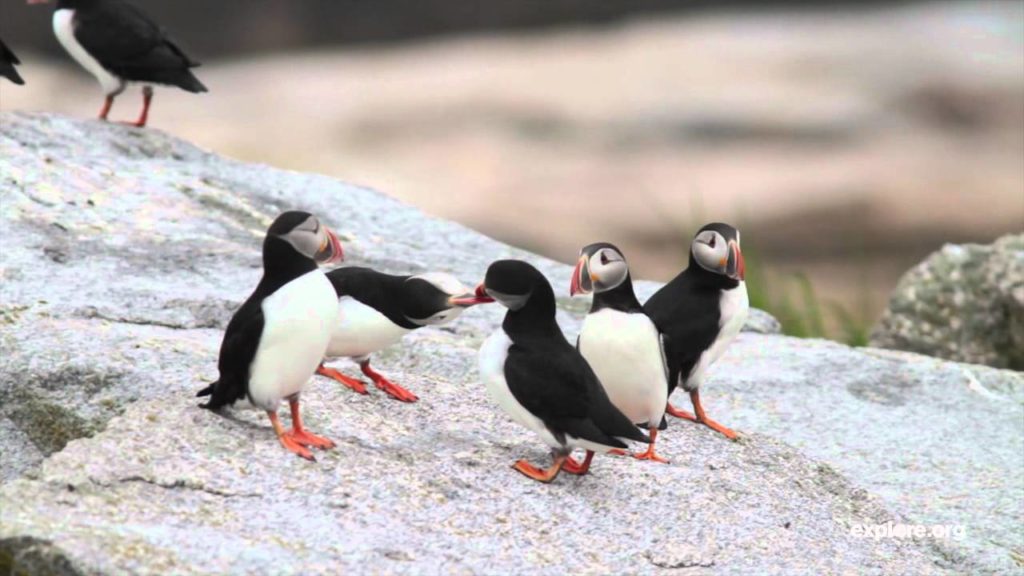Atlantic Puffins Breed on Maine Refuge
Seal Island National Wildlife Refuge, off the coast of Maine, is home to Atlantic Puffins, Roseate Terns, Great Cormorants, and other breeding seabirds.
A rocky island off the coast of Rockland Maine, Seal Island is the site of growing colonies of breeding sea birds, some of them endangered species, or species that have been rare in the United States. Seal Island National Wildlife Refuge is part of the Maine Coastal Islands National Wildlife Refuge, a group of five national wildlife refuges encompassing 47 offshore islands and three mainland areas. The Maine Coastal Islands National Wildlife Refuge is managed by the U. S. Fish and Wildlife Service.
Where is Seal Island?
Seal Island lies off the coast of Maine, about 32 kilometers south of Rockland Maine (20 miles). A rocky island that rises about 20 meters (65 feet) above sea level at its highest point, it is somewhat inaccessible to people, but a perfect island refuge for breeding seabirds.
Seal Island is not open to the public because of the presence of live ordnance left by the U. S. Navy in the past. However, the public is welcome at the Project Puffin Visitor Center in Rockland Maine, where videos, exhibits and live remote cameras allow visitors to learn about and view the Atlantic puffins and other seabirds on offshore islands.
What’s on Seal Island?
Seal Island National Wildlife Refuge is a long narrow treeless island with an undulating rocky coastline. Visitors to Seal Island would find:
- rocky ledges and tumbled boulders.
- grasslands.
- low-growing shrubby plants such as raspberry canes.
- peat and glacial till (mixed clay, stones, gravel, and rock).
- large nesting colonies of Atlantic Puffins, Common Terns and Arctic terns, and smaller numbers of burrowing Leach’s Storm Petrels, nesting Roseate Terns, Great Cormorants, razorbills, and other seabirds.
- particularly during spring and fall migration, songbirds, shorebirds, and raptors.
- A grey seal pupping area.
- Live ordinance left from the days when Seal Island was used as a bombing range.
- Bird decoys and live cameras positioned to give people a live window on Atlantic Puffins, terns and other sea birds during the breeding season.
The history of seabirds on Seal Island
When European settlers first came to North America there were doubtless even more sea birds on Seal Island than there are today, but human activities destroyed these bird breeding colonies by the end of the 19th century. Here’s a brief timeline of the history of what is now the Seal Island National Wildlife Refuge:
- 1700s and 1800s – Fisherman used the island as a launching point for fishing and harvested birds and eggs from seabird colonies.
- 1887 – Breeding seabirds were virtually eradicated from Seal Island.
- Early 1900 – hunting of birds was prohibited on Seal Island. Gulls, eiders, cormorants and other seabirds began to come back.
- 1940s through 1960s – Seal Island was used as a bombing range by the U. S. navy.
- 1972 – Seal Island came under the control of the U. S. Fish and Wildlife Service, and a program to control gulls was implemented.
- 1984 through 1989 – national Audubon worked with the U. S. Fish and Wildlife Service to reintroduce Atlantic Puffins to Seal Island.
- 1992 – Atlantic Puffins began to breed on Seal Island—these were both birds introduced to the island and birds born in the wild on nearby islands.
- 1992 – Razorbills began to breed on the island.
- 2002 – The Common and Arctic Tern colony on the island was the largest on the Maine coast with more than 2600 pairs.
- 2003 – More than 230 pairs of Atlantic Puffins nested on the Seal Island National Wildlife Refuge.
- 2007 – Remote cameras on Seal Island let people watch puffins, see inside a puffin burrow, and view breeding terns.
Techniques used to bring puffins and other sea birds back to the Seal Island National Wildlife Refuge have helped other bird reintroduction projects around the world.

